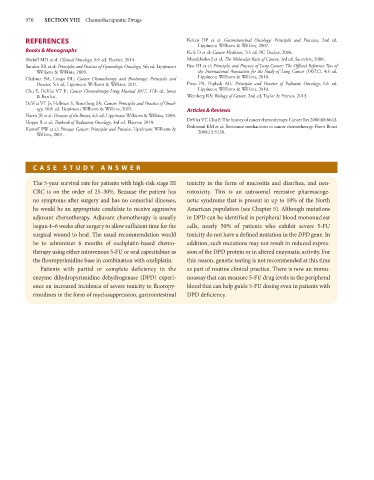Page 990 - Basic _ Clinical Pharmacology ( PDFDrive )
P. 990
976 SECTION VIII Chemotherapeutic Drugs
REFERENCES Kelsen DP et al: Gastrointestinal Oncology: Principles and Practices, 2nd ed.
Lippincott Williams & Wilkins, 2007.
Books & Monographs Kufe D et al: Cancer Medicine, 7th ed. BC Decker, 2006.
Abeloff MD et al: Clinical Oncology, 5th ed. Elsevier, 2014. Mendelsohn J et al: The Molecular Basis of Cancer, 3rd ed. Saunders, 2008.
Barakat RR et al: Principles and Practice of Gynecologic Oncology, 5th ed. Lippincott Pass HI et al: Principles and Practice of Lung Cancer: The Official Reference Text of
Williams & Wilkins, 2009. the International Association for the Study of Lung Cancer (IASLC), 4th ed.
Chabner BA, Longo DL: Cancer Chemotherapy and Biotherapy: Principles and Lippincott Williams & Wilkins, 2010.
Practice, 5th ed. Lippincott Williams & Wilkins, 2011. Pizzo PA, Poplack AG: Principles and Practice of Pediatric Oncology, 6th ed.
Chu E, DeVita VT Jr: Cancer Chemotherapy Drug Manual 2017, 17th ed. Jones Lippincott Williams & Wilkins, 2010.
& Bartlett. Weinberg RA: Biology of Cancer, 2nd ed. Taylor & Francis, 2013.
DeVita VT Jr, Hellman S, Rosenberg SA: Cancer: Principles and Practice of Oncol-
ogy, 10th ed. Lippincott Williams & Wilkins, 2015. Articles & Reviews
Harris JR et al: Diseases of the Breast, 4th ed. Lippincott Williams & Wilkins, 2009.
Hoppe R et al: Textbook of Radiation Oncology, 3rd ed. Elsevier, 2010. DeVita VT, Chu E: The history of cancer chemotherapy. Cancer Res 2008;68:8643.
Kantoff PW et al: Prostate Cancer: Principles and Practice. Lippincott Williams & Redmond KM et al: Resistance mechanisms to cancer chemotherapy. Front Biosci
2008;13:5138.
Wilkins, 2001.
C ASE STUD Y ANSWER
The 5-year survival rate for patients with high-risk stage III toxicity in the form of mucositis and diarrhea, and neu-
CRC is on the order of 25–30%. Because the patient has rotoxicity. This is an autosomal recessive pharmacoge-
no symptoms after surgery and has no comorbid illnesses, netic syndrome that is present in up to 10% of the North
he would be an appropriate candidate to receive aggressive American population (see Chapter 5). Although mutations
adjuvant chemotherapy. Adjuvant chemotherapy is usually in DPD can be identified in peripheral blood mononuclear
begun 4–6 weeks after surgery to allow sufficient time for the cells, nearly 50% of patients who exhibit severe 5-FU
surgical wound to heal. The usual recommendation would toxicity do not have a defined mutation in the DPD gene. In
be to administer 6 months of oxaliplatin-based chemo- addition, such mutations may not result in reduced expres-
therapy using either intravenous 5-FU or oral capecitabine as sion of the DPD protein or in altered enzymatic activity. For
the fluoropyrimidine base in combination with oxaliplatin. this reason, genetic testing is not recommended at this time
Patients with partial or complete deficiency in the as part of routine clinical practice. There is now an immu-
enzyme dihydropyrimidine dehydrogenase (DPD) experi- noassay that can measure 5-FU drug levels in the peripheral
ence an increased incidence of severe toxicity to fluoropy- blood that can help guide 5-FU dosing even in patients with
rimidines in the form of myelosuppression, gastrointestinal DPD deficiency.

